Biržai
Biržai (![]()
Biržai | |
|---|---|
Town | |
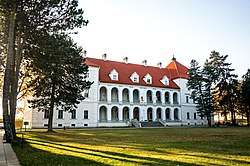 | |
 Coat of arms | |
 Biržai Location of Biržai | |
| Coordinates: 56°12′N 24°45′E | |
| Country | |
| Ethnographic region | Aukštaitija |
| County | |
| Municipality | Biržai district municipality |
| Eldership | Biržai town eldership |
| Capital of | Biržai district municipality Biržai town eldership Širvėna eldership |
| First mentioned | 1455 |
| Granted Town rights | 1589 |
| Population (2001) | |
| • Total | 15,262 |
| Time zone | UTC+2 (EET) |
| • Summer (DST) | UTC+3 (EEST) |
| Website | http://www.birzai.lt/ |
Names
The name of the town is of Lithuanian origin and is spelled in different forms in other languages: Birsen (German), Birże (Polish), Birzhai (Биржай, Russian - pre-1917 Биржи), and בירז/Birz or Birzh (Yiddish) [1] and simplified to Birzai in English.
History
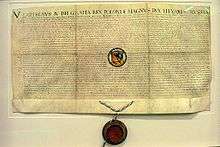
The town's first written mention dates to 1455. The construction of Biržai Castle began in 1586, and the town was granted Magdeburg Rights in 1589.[2] In 1575, as preparation for the castle's construction, a dam was built on the Agluona and Apaščia Rivers at their confluence, and the artificial Lake Širvėna, covering about 40 km2 (15 sq mi), was created. It is the oldest surviving artificial lake in Lithuania. The town's history is closely associated with the Radziwiłł family (Lithuanian: Radvila). Jerzy Radziwiłł was the first noble to settle in the town. Later, after his daughter, Barbara Radziwiłł married the Grand Duke of Lithuania and King of Poland Sigismund II Augustus in 1547, the power and influence of the family grew immensely. The Radvila family established a Protestant church and school, and the town became a cultural center of the Protestant Reformation in Lithuania.
The local community of Lithuanian Jews, which settled in the Duchy of Biržai at the end of the 16th century, was influential, establishing an interest-free loan society, two major flour mills, and an international linen export business.[1] The Islamic Lipka Tatars performed military, police, and postal duties for the Radziwill family.[3]
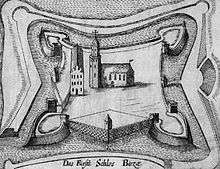
During the Wars with Sweden, Biržai Castle was an important point of defence. In 1625, Gustavus Adolphus, king of Sweden, attacked the castle with 8,000 soldiers and it was forced to surrender. The castle was left in ruins and was rebuilt, only to be burnt in 1655. In 1662–1669, it was rebuilt again in Renaissance style. On 9 March 1701, August II the Strong and Peter I of Russia (Peter the Great) signed a pact in the castle to unite their forces against Sweden. However, in 1704 the castle was completely destroyed and was left in ruins until its restoration in the 1990s.
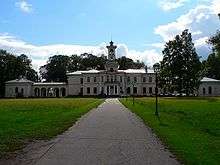
The town's population suffered greatly due to wars and religious conflicts between the Protestants and Catholics. In the late 18th century, Biržai lost its town rights. The Radziwiłłs lost their wealth and influence, and Biržai was sold to the Tyszkiewicz family to cover debts in 1811. In 1849–1862, the Tyszkiewicz family built a neoclassic Astravas Manor palace across the lake from the site of the original castle.
In 1869 the town had about 2,600 residents. Thirty years later the population had grown to 4,400.
During World War II, the entire Jewish population of Biržai was annihilated. 15 Jews were shot to death by German soldiers at the Biržai Jewish cemetery in July 1941.[4] On 8 August 1941, Gestapo and Lithuanian collaborators murdered the entire Jewish population of the town, some 2,400 people, by shooting them to death at a mass grave in a forest grove 3 kilometres (1.9 miles) outside the town.[5] The town was almost completely burned down during the war. Oldtown was destroyed.
In 1968 the population reached 10,000. Currently there are 15,000 people living in Biržai.
Architecture
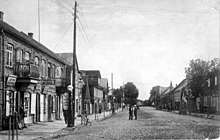
After the unrest and conflicts have settled down, from the 19th-century wooden residential houses prevailed and with an ongoing industrial revolution at the time, asbestos or metal-sheet roofing was common. With the majority of buildings being wooden, masonry buildings eventually emerged to battle cold winters and hot summers. In the early 20th century, central roads were cobblestone. During the World Wars, the old town was destroyed and the majority of wooden buildings in the main street burned down.
During the Soviet rule, the town's population grew twice its previous size. To accommodate the growth, around 60 new apartment buildings were constructed and main streets asphalted. There was also an increase in new houses being built from bricks instead of wood, and the majority of them were left not plastered.
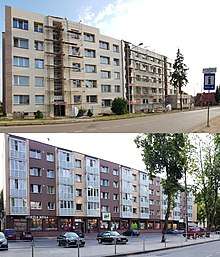
With the help of European Union's Development Assistance grants, the town was able to regain a unique style - since 2014 numerous apartment building renovations were carried out with more planned, the road infrastructure is being improved and some new constructions built to attract visitors and to restore the historic appearance.


Geography
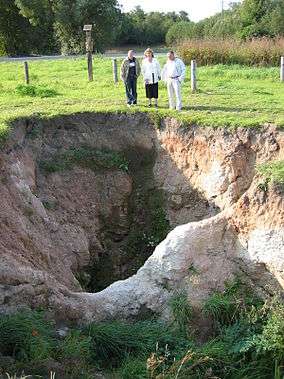
The northern part of the town, along with Lake Širvėna, lies within Biržai Regional Park. About 9,000 sinkholes have been identified in the park,[6] formed abruptly after gypsum in the soil has been dissolved by underground water. Some of these holes are dry, while others have become small ponds or lakes filled with water from the many underground rivers and streams. New holes appear annually. According to local legend, the 20-meter-deep sinkhole known as Karves ola (Cow's Cave) was discovered by a farmer after his cow disappeared. A tunnel at its bottom leads to a cave and underground lake.[7]
Climate
| Climate data for Biržai | |||||||||||||
|---|---|---|---|---|---|---|---|---|---|---|---|---|---|
| Month | Jan | Feb | Mar | Apr | May | Jun | Jul | Aug | Sep | Oct | Nov | Dec | Year |
| Record high °C (°F) | 8.4 (47.1) |
13.0 (55.4) |
18.8 (65.8) |
26.1 (79.0) |
30.7 (87.3) |
33.3 (91.9) |
36.4 (97.5) |
33.3 (91.9) |
29.2 (84.6) |
22.7 (72.9) |
16.2 (61.2) |
10.5 (50.9) |
36.4 (97.5) |
| Average high °C (°F) | −3.1 (26.4) |
−2.2 (28.0) |
2.5 (36.5) |
10.1 (50.2) |
17.6 (63.7) |
21.0 (69.8) |
22.0 (71.6) |
21.3 (70.3) |
16.2 (61.2) |
10.2 (50.4) |
3.6 (38.5) |
−0.8 (30.6) |
9.9 (49.8) |
| Daily mean °C (°F) | −5.7 (21.7) |
−5.2 (22.6) |
−1.2 (29.8) |
5.5 (41.9) |
12.1 (53.8) |
15.7 (60.3) |
16.7 (62.1) |
15.9 (60.6) |
11.4 (52.5) |
6.7 (44.1) |
1.5 (34.7) |
−3.2 (26.2) |
5.9 (42.6) |
| Average low °C (°F) | −8.6 (16.5) |
−8.4 (16.9) |
−4.4 (24.1) |
1.7 (35.1) |
6.7 (44.1) |
10.3 (50.5) |
11.8 (53.2) |
11.0 (51.8) |
7.4 (45.3) |
3.4 (38.1) |
−0.9 (30.4) |
−5.9 (21.4) |
2.0 (35.6) |
| Record low °C (°F) | −35.1 (−31.2) |
−35.5 (−31.9) |
−29.5 (−21.1) |
−16.7 (1.9) |
−4.1 (24.6) |
0.1 (32.2) |
3.5 (38.3) |
0.4 (32.7) |
−5.3 (22.5) |
−10.8 (12.6) |
−20.4 (−4.7) |
−31.4 (−24.5) |
−35.5 (−31.9) |
| Average precipitation mm (inches) | 32 (1.3) |
24 (0.9) |
34 (1.3) |
40 (1.6) |
52 (2.0) |
58 (2.3) |
77 (3.0) |
71 (2.8) |
64 (2.5) |
55 (2.2) |
52 (2.0) |
46 (1.8) |
605 (23.8) |
| Source 1: NOAA[8] | |||||||||||||
| Source 2: JOnis.eu[9] & JOnis.eu[10] | |||||||||||||
Notable people
- Jurgis Bielinis, publicist and one of the main organizers of illegal book-smuggling (knygnešiai) at the time of the Lithuanian press ban
- Kazys Binkis, poet, playwright
- Romualdas Brazauskas, basketball referee
- Bernardas Brazdžionis, poet
- Vladas Garastas, basketball coach
- Petras Kalpokas, painter
- Pinchas HaKohen Lintup (1851–1924), rabbi of Hasidic community
- Jonas Mekas, film maker
- Alfonsas Petrulis, signatory of the Act of Independence of Lithuania
- Jerzy Radziwiłł, Great Hetman of Lithuania
- Žydrūnas Savickas, strongman
- Jokūbas Šernas, signatory of the Act of Independence of Lithuania
- Austra Skujytė, olympic silver medal winner
- Janusz Skumin Tyszkiewicz
- Balys Sruoga, poet, playwright, critic, and literary theorist
- Elchonon Wasserman, Lithuanian rabbi, disciple of Chofetz Chaim
- Vytautas Laisonas, Lithuanian national painter
Sport
- FK Širvėna Biržai (football club);
- Biržai Stadium (The current capacity of the stadium is 1,000 seats.);
- KK Biržai (basketball club).
External links
References
| Wikimedia Commons has media related to Biržai. |
- Official website of Biržai district municipality
- Historical map of Lithuania by Jean Baptiste Bourguignon Anville with Birze
Footnotes
- "BIRZAI: Kovno". International Association of Jewish Genealogical Societies. Retrieved 2009-07-01.
- "Istorija" (in Lithuanian). City of Biržai. Retrieved 2009-07-22.
- "SUMMARY - ŽIEMGALA INVESTIGATIONS". Žiemgala Journal. Archived from the original on 2007-08-23. Retrieved 2009-06-30.
- "Mass Murder of the Jews at Biržai Jewish Cemetery". Holocaust Atlas of Lithuania. Vilna Gaon State Jewish Museum. Retrieved 27 May 2014.
- "Mass Murder of the Jews from Biržai at the Pakamponys Forest". Holocaust Atlas of Lithuania. Vilna Gaon State Jewish Museum. Retrieved 27 May 2014.
- "PROJECT ENVIRONMENT". European Commission. Archived from the original on 2012-10-24. Retrieved 2009-06-16.
- Mullett, Adam (2008-06-18). "A visit to holey ground". The Baltic Times. Retrieved 2009-06-19.
- "Biržai Climate Normals 1961–1990". National Oceanic and Atmospheric Administration. Retrieved March 22, 2015.
- "Web Archive of highest recorded temperature on jonis.eu, based in Biržai". Jonas, Biržai. Retrieved July 30, 2018.
- "Web Archive of highest recorded temperature on jonis.eu, based in Biržai". Jonas, Biržai. Retrieved September 21, 2018.
